Crispy, juicy and absolutely delicious! Give this traditional Keftedes / Keftethes (Greek Meatballs) recipe a try and add a Mediterranean twist to your plate! Just like normal meatballs but with a deliciously fresh Greek twist, this dish can be anything from a light meal to the main course but also a star of the mezze platter.
So read along to discover my traditional recipe, variations, side dish suggestions and my tips and tricks to make them to perfection!
What is Keftedes (Greek Meatballs)?
Keftedes (Greek meatballs) is a famous Greek appetizer, commonly served as part of a meze platter, with some creamy tzatziki sauce and pita breads, and as a side to a slice of delicious traditional Greek Moussaka. Keftedes can also be served as a filling meal with some basmati rice and a nice Greek feta salad.
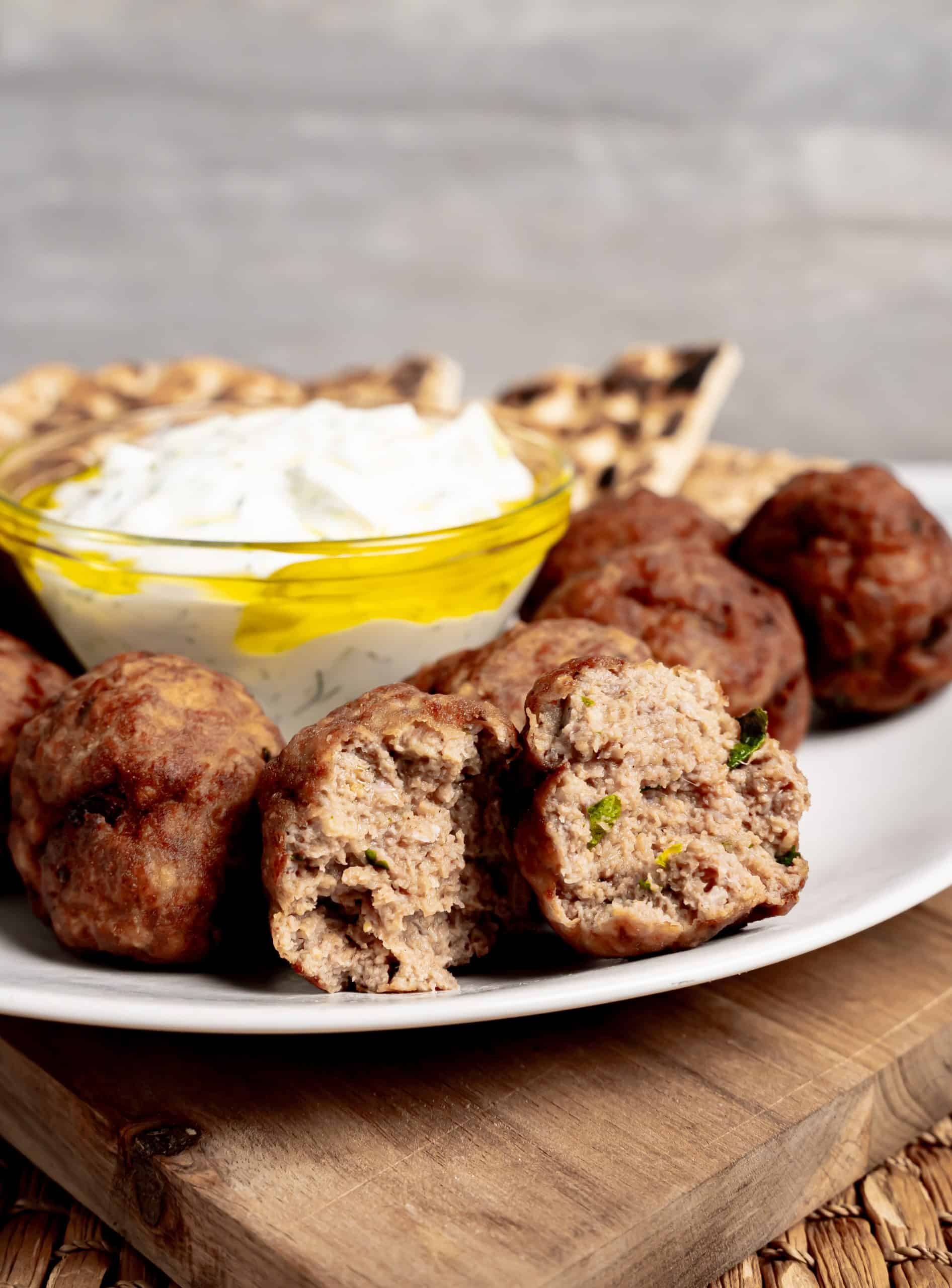
Leftovers (which is a good thing in this case!) make a delicious brand new dish, added in a tomato-based sauce with some mashed potatoes, or pasta.
- Mezze platter: This dish often features in mezze platters but can also be a meal in its own right
- Loads of leftover uses: You can also make bigger batches and create other recipes with the leftovers like spaghetti with meatballs!
What you’ll need to make Greek meatballs the traditional way
- Ground Meat: You’ll want some good quality ground beef and ground pork for your meatballs. I personally use beef mince with 15% fat content and a 12% fat pork mince as I find it gives the most flavor to my meatballs! However if you want to go healthier, use a lean beef and pork mince (5% fat) together with baking them instead of pan-frying them.
- Herbs & spices: You’ll need some garlic, red onion and red wine vinegar, together with some fresh parsley, spearmint and oregano. If you can’t find spearmint, substitute with about half the quantity of regular mint as spearmint is sweeter and less intense.
- Egg and some stale bread: is used to bind the mixture. You can substitute the stale bread with some panko or plain breadcrumbs. However, the panko ones make your meatballs more fluffy!
- Olive oil is best for frying the meatballs and you’ll want a little flour as well for dredging them just before cooking.
Key Preparation Steps
There’s only really two steps involved with making meatballs:
- Make the meatballs by adding the ingredients together
- Cook the meatballs either by frying or oven cooking
Make the meatballs
To make Greek pork meatballs (keftedes), combine all of the ingredients in a large mixing bowl and mix thoroughly for 5-10 minutes, squeezing with your hands to blend the flavors. Cover the mixture with plastic wrap and refrigerate for 1 hour.
Turn the keftedes out of the fridge and roll them into meatballs about the size of a walnut (or bigger if you prefer). If you’re frying them, lightly flour them before frying to ensure even browning.
Cook the meatballs
Greek meatballs (keftedes) are traditionally cooked in a frying pan. Fry the keftedes in batches of 10-15 at a time, until golden brown on all sides.
Instead of frying, you may bake / grill the keftedes in the oven. Preheat the oven to 200°C/390F and line a baking sheet with un-floured keftedes about an inch apart.
Bake for 20 minutes, turning the meatballs upside down halfway through cooking time. Because this is grilled rather than fried, it is perfect if you want a healthier option!
What’s the difference between Greek meatballs and normal meatballs?
Greek meatballs are typically made with ground pork and beef and seasoned with a variety of Greek herbs and spices. This mixture is then formed into small balls and fried until golden brown. Their unique flavour comes from their Mediterranean herbs – with parsley, spearmint and oregano giving them that deliciously fresh flavour!
Your regular meatballs, on the other hand, can be made with any type of ground meat, including pork, chicken, or turkey. The seasonings used in regular meatballs are also different, ranging from Italian-style herbs to Asian-inspired flavors.
Variations
Feeling cold? Then the traditional Greek meatballs soup in egg and lemon sauce (avgolemono) is the perfect heartwarming dish! It is a classic delicacy made basically with boiled juicy Greek meatballs (youvarlakia) and rice and finished off with delicious egg-lemon sauce.
If you love your meatballs with a tangy tomato sauce, then the traditional, fragrant soutzoukakia recipe is made for you!
Soutzoukakia is an amazing Greek recipe that was introduced to Greek cuisine at the beginning of the 20th century and has its origin in the city of Smyrni or modern day Izmir. The secret ingredient that makes these oblong-shaped Greek meatballs really unique is nothing else than cumin!
Last but not least, a very unique variation of the traditional fried Greek meatballs (keftedes), served as a main dish, is keftedes giouvetsi (Greek meatballs in tomato sauce).
The traditional diced beef of the giouvetsi is substituted with crispy fried meatballs (keftedes) and then baked in a rich tomato based sauce and orzo pasta or chilopites. Just too good to miss out on! Oh and you can always read this delicious recipe in Greek here Κεφτεδάκια τηγανητά συνταγή.
Making ahead of time and storing
These Greek meatballs can be stored in the refrigerator for three to four days. To serve, just reheat in the microwave, stove, oven or in your crock pot.
- To reheat in the microwave, place desired number of meatballs on a microwave-safe plate and cook for 30 seconds. Then, just until heated through, repeat at 15-second intervals
- To reheat on the stove, melt some butter in a large nonstick skillet or add a few drops of olive oil (I use both). Add the meatballs and cook over medium-low heat, stirring frequently until heated through.
- To reheat in the oven, put them in a baking dish and cover them with foil. Bake for 10 minutes at 325 degrees to warm through.
- To reheat in the crockpot, transfer keftedes to a lightly greased crockpot. Reheat over low for 1-2 hours, or until completely heated through, stirring 1-2 times. For extra juicy meatballs, drizzle with olive oil or melted butter while reheating.
You can also make the mixture ahead of time, cover with plastic wrap, chill, then cook when ready. Allow the meatballs to sit on the counter for 30 minutes before cooking to bring them to room temperature.
Serving suggestions
Keftedes (Greek meatballs) are ideally served as an appetizer (meze) with some creamy tzatziki sauce and pita breads or as a main course with some basmati rice and a Greek salad.
If you love my traditional meatballs recipe, these recipes below are made for you!
- Crispy Greek Lamb Meatballs recipe (Keftedes Arni)
- Traditional Soutzoukakia recipe (Greek baked Meatballs in tomato sauce)
- Traditional Greek Meatball Soup (Giouvarlakia/ Youvarlakia) in egg and lemon sauce
- Greek Meatballs in Tomato Sauce (Keftedes Giouvetsi)
- Juicy Stuffed Burgers with Feta Cheese

Greek Meatballs recipe (Keftedes/ Keftethes)
- Prep Time: 60 min
- Cook Time: 30 min
- Total Time: 1 hour 30 minutes
- Yield: 40 pieces 1x
- Category: Appetizer
- Method: Fried
- Cuisine: Greek
Description
A crispy, juicy and absolutely delicious Greek meatballs (keftedes) recipe! Keftedes is a famous Greek appetizer, commonly served as part of a meze platter, with some creamy tzatziki sauce and pita breads. Find out how to make it to perfection with this traditional Greek recipe.
Ingredients
- 500g ground beef (18 ounces)
- 200g ground pork (7 ounces)
- 1 medium red onion, grated
- 1 medium clove of garlic, minced
- 150g stale bread (5 oz.), soaked in water and squeezed to remove the excess water
- 1 large egg
- 1 1/2 tbsp fresh parsley, chopped (optional)
- 1 1/2 tbsp fresh spearmint (chopped) and a pinch dried. Or 3/4 tbsp fresh regular mint
- 2 tbsps olive oil
- 1 1/2 tbsps red wine vinegar
- 1 teaspoon oregano
- 1 teaspoon salt
- 1 teaspoon pepper
- oil for frying
- flour for dredging
Instructions
- To prepare this traditional Greek meatballs recipe (keftedes), add all the ingredients into a large bowl and mix well (for about 5-10 minutes), squeezing with your hands, to allow the flavours to blend. Cover the bowl with some plastic wrap and let it rest in the fridge for 1 hour.
- Turn the mixture for the keftedes out of the fridge and roll into meatballs the size of a walnut (or bigger if you prefer). If you’re frying them, dredge the rolled meatballs lightly in flour making sure to shake off any excess. Fry until nicely browned on all sides.
- The traditional way of cooking Greek meatballs (keftedes) is frying them. Fry the keftedes in batches of 10-15 at a time, until nicely browned on all sides.
- Instead of frying you can bake / grill the keftedes in the oven. Preheat the oven at 200C, place the un-floured keftedes on greased baking sheet about an inch apart. Bake for about 20 minutes, turning the meatballs upside down midway through cooking time. The grilled version is much lighter than the fried so theres not excuse to not trying it now!
- Keftedes (Greek meatballs) are ideally served as an appetizer (meze) with some creamy tzatziki sauce and pita breads or as a main course with some basmati rice and a Greek salad. Enjoy!
Nutrition
- Serving Size: 1 piece
- Calories: 63kcal
- Sugar: 0.3g
- Sodium: 91.2mg
- Fat: 2.8g
- Saturated Fat: 0.8g
- Unsaturated Fat: 1.7g
- Trans Fat: 0g
- Carbohydrates: 4.7g
- Fiber: 0.3g
- Protein: 4.5g
- Cholesterol: 15.8mg

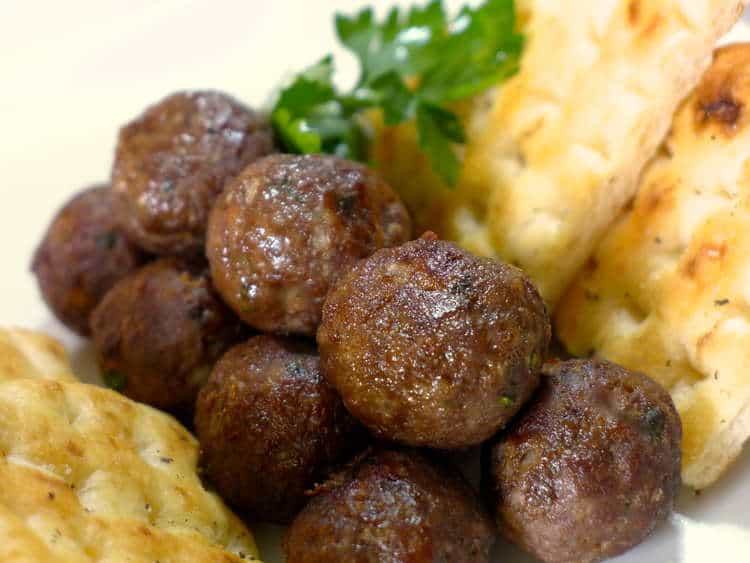

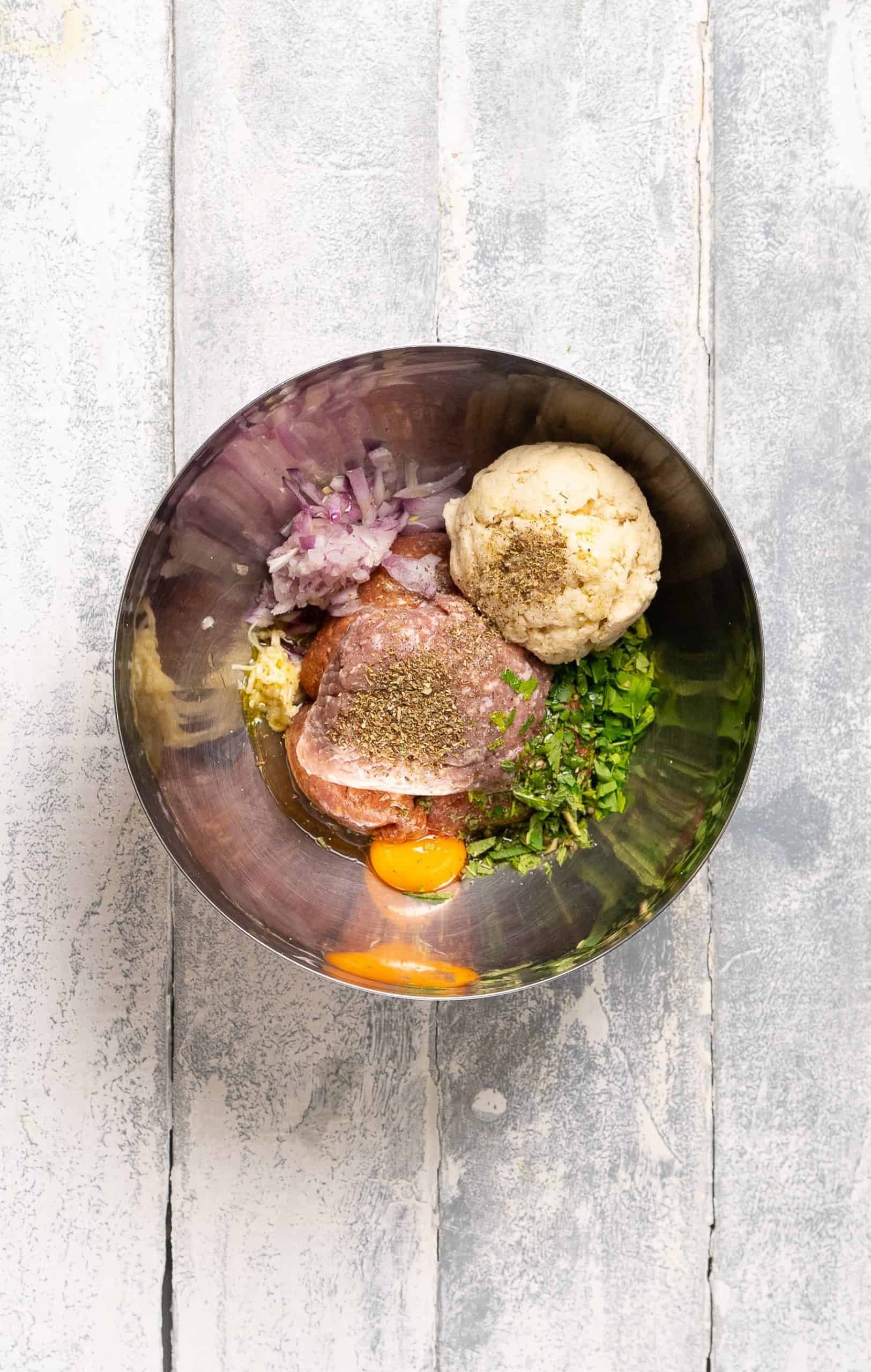
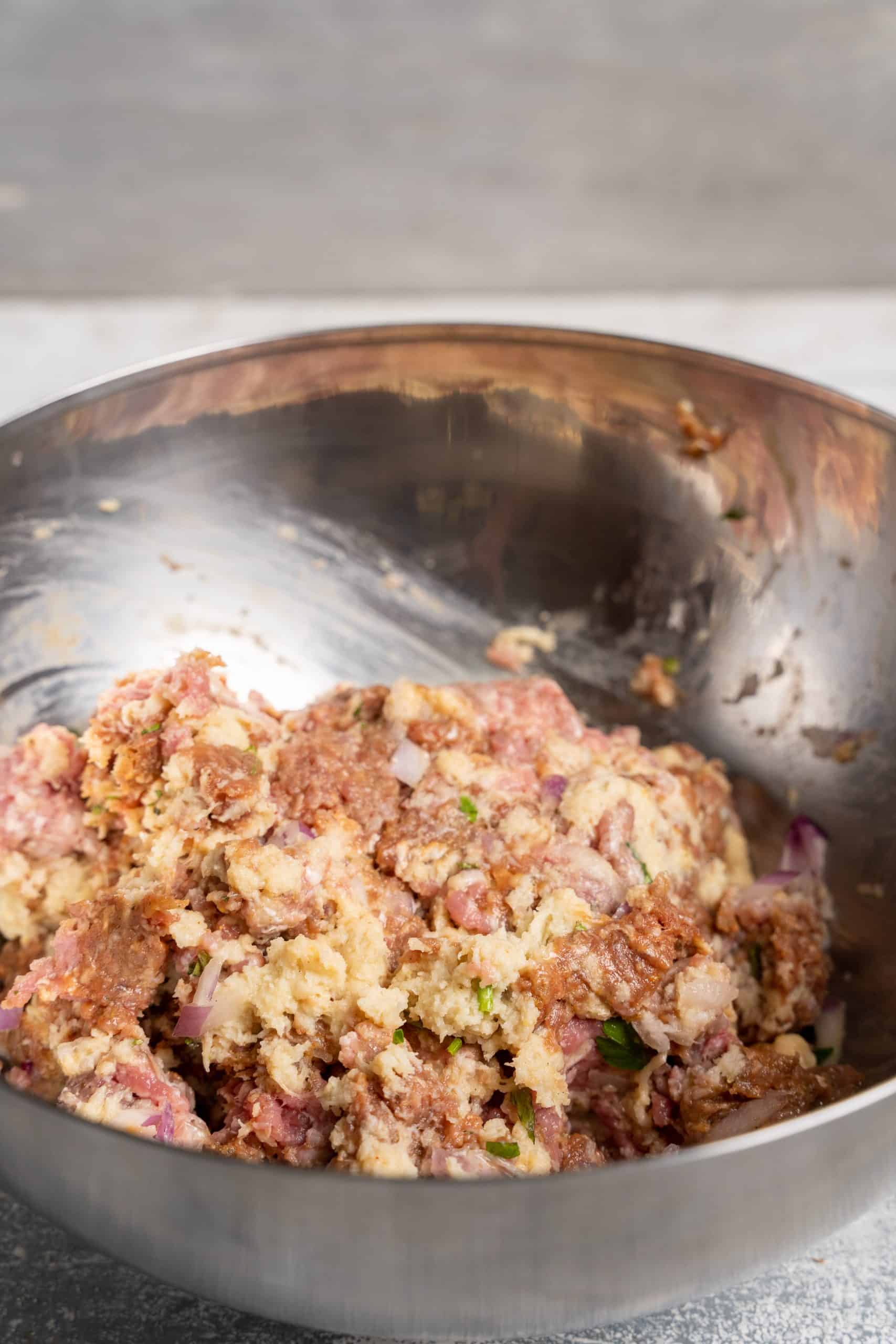
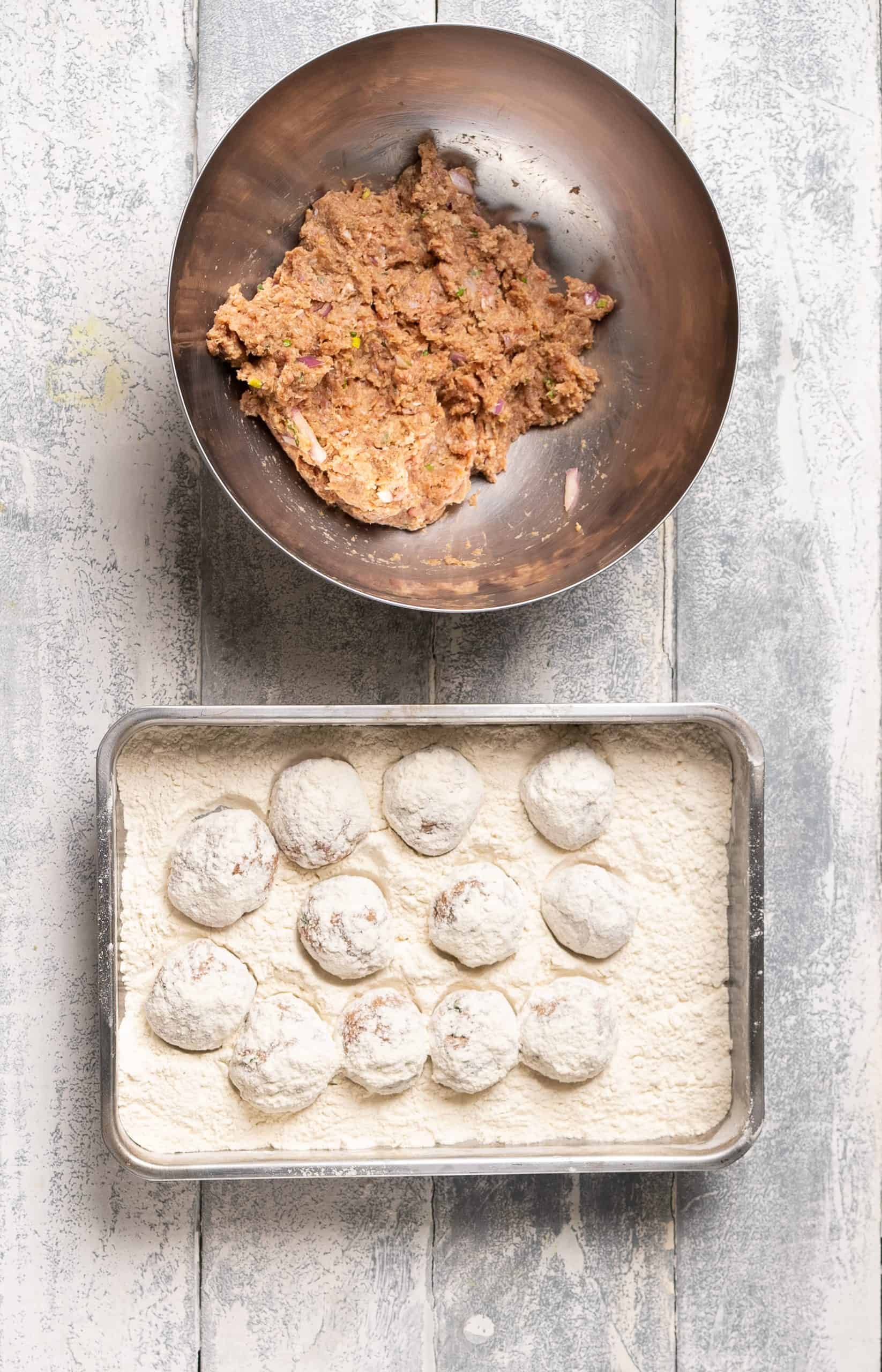
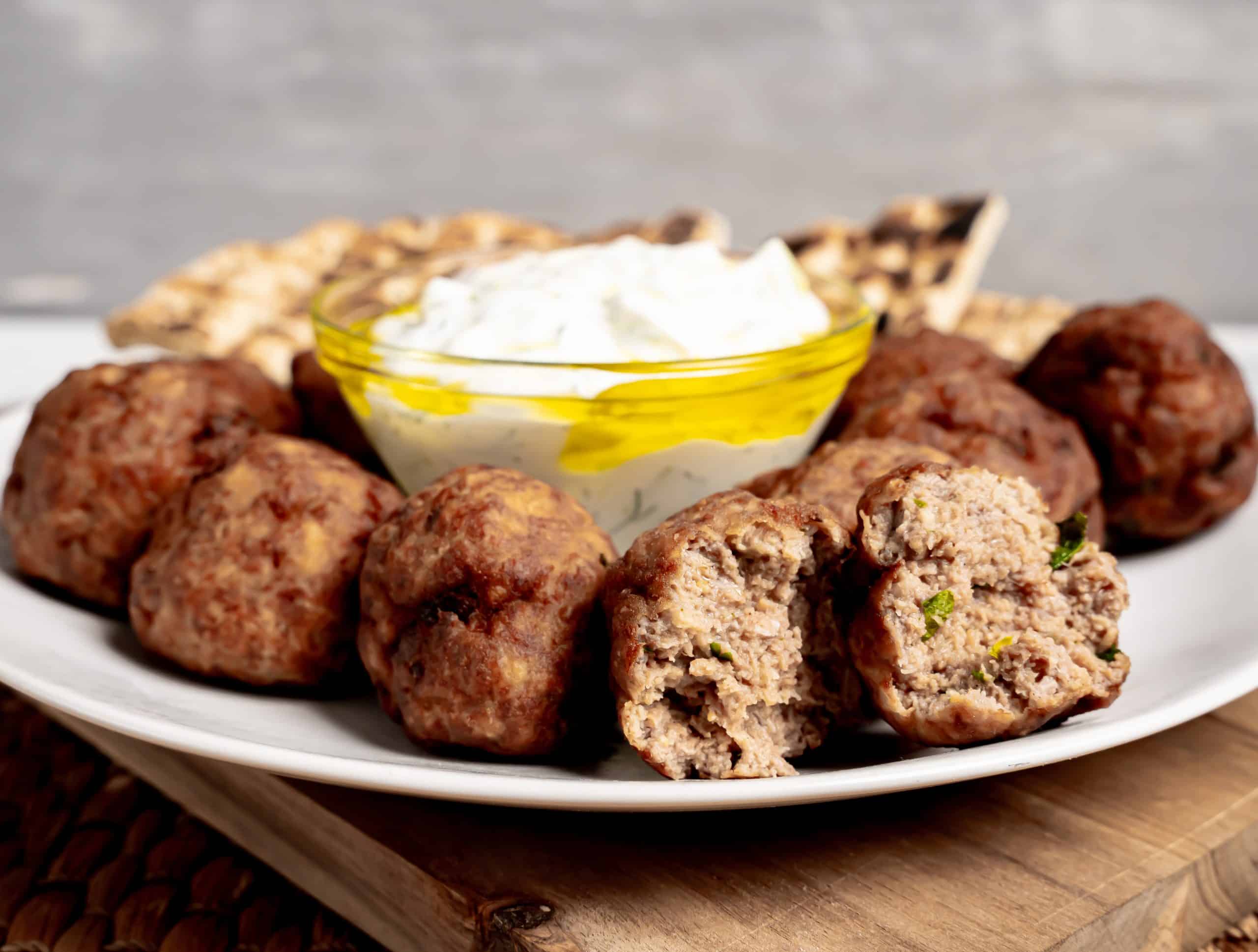
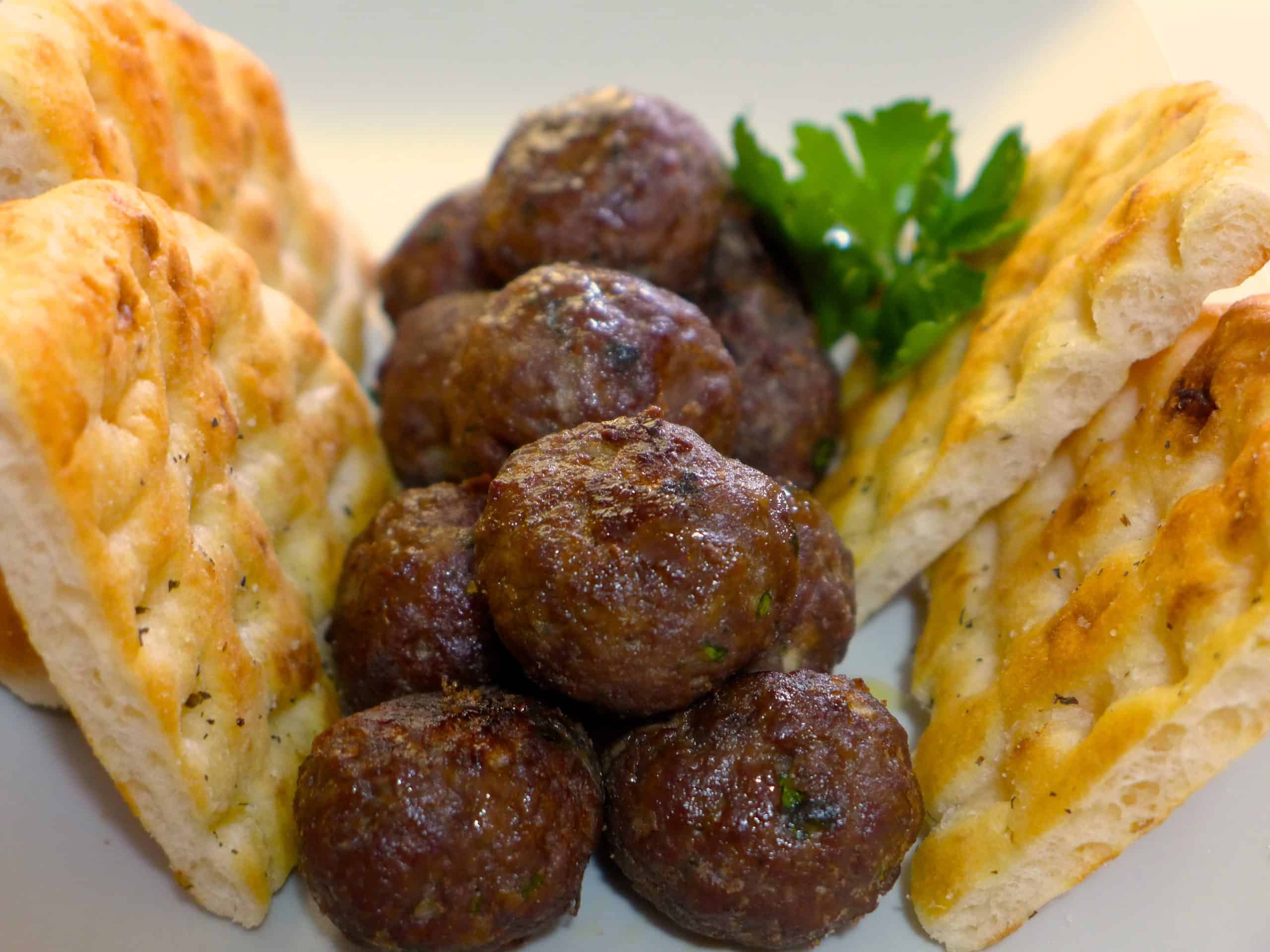
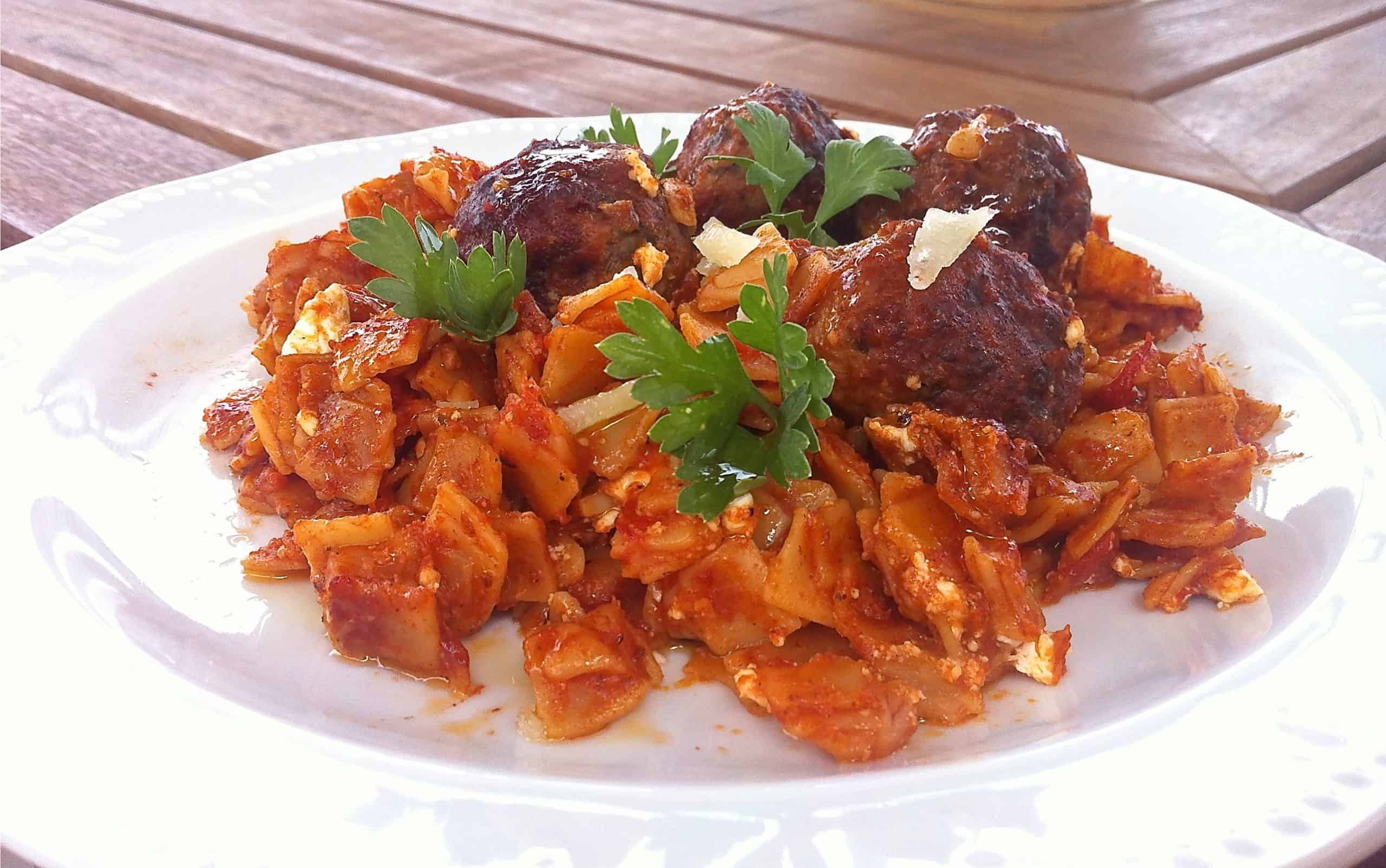
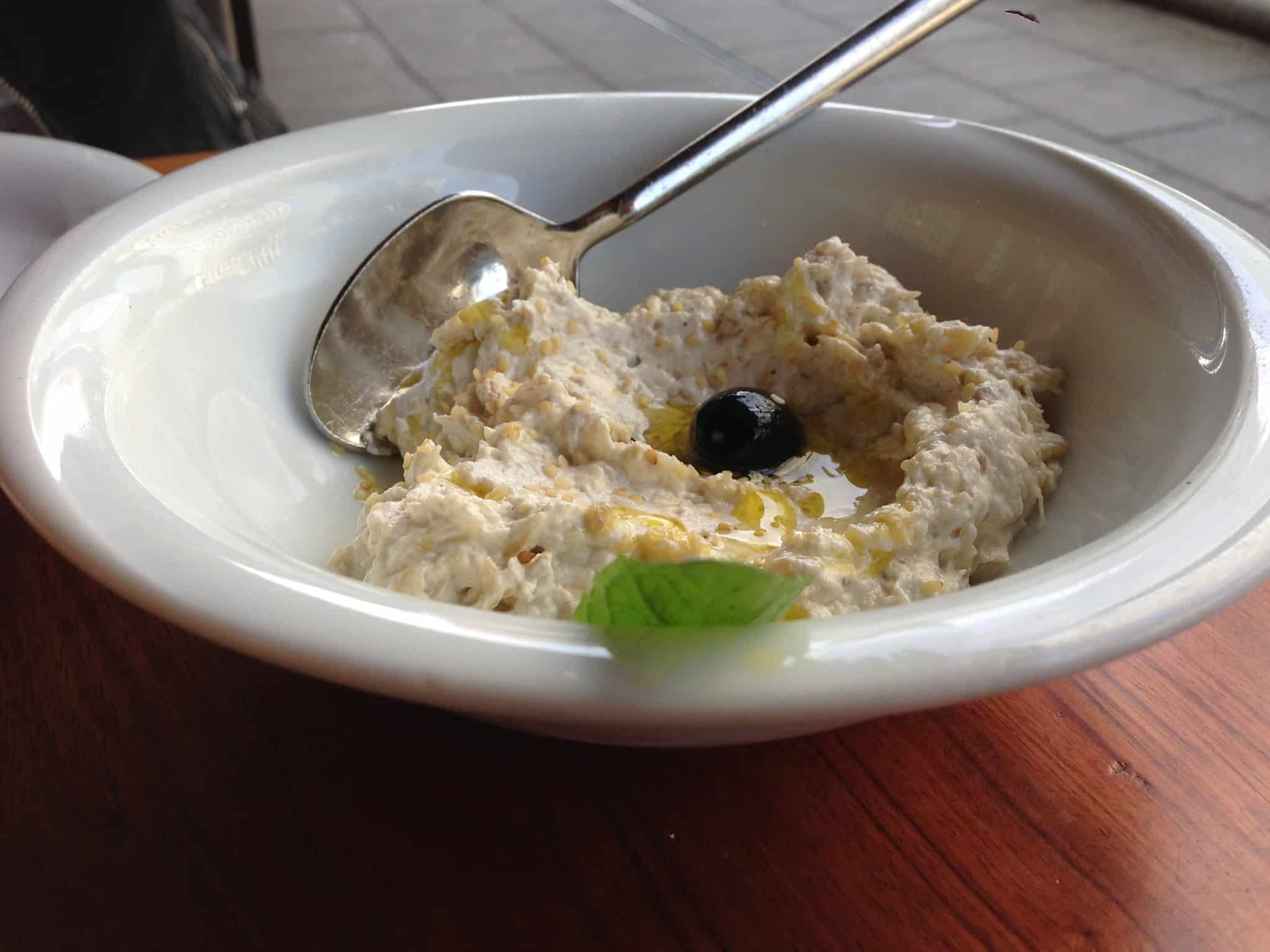
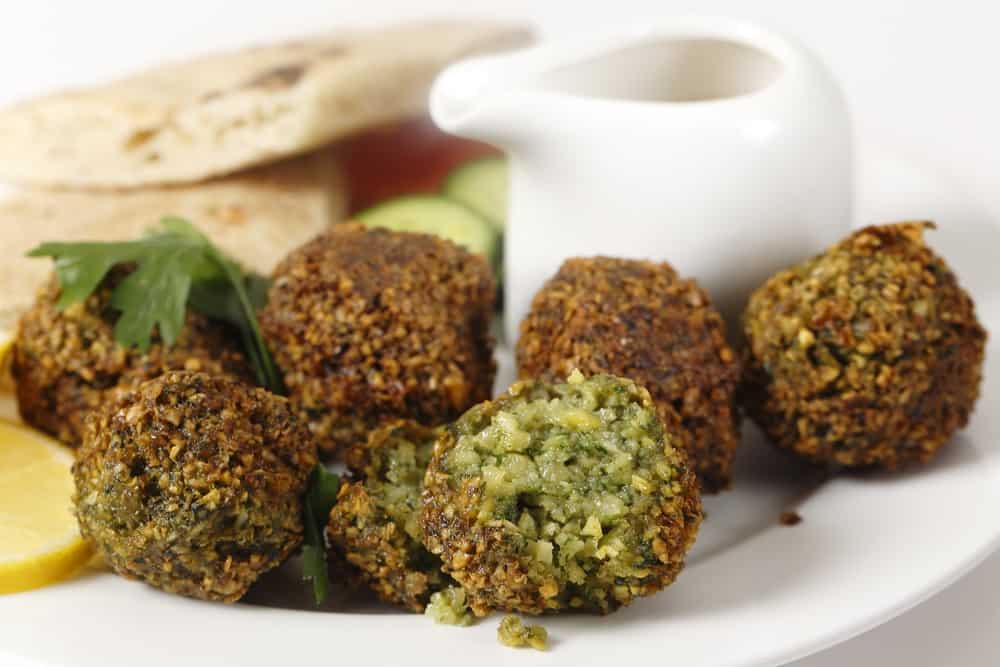

I hate when people leave comments like Nina did! If you have a remark to make please give an explanation otherwise it sounds like an old person’s grump:-)). Huge thank you to you, guys, making such a wonderful web-site with amazing pictures and detailed instructions!!! And a history behind every dish. I want to try every single recipe and once i will i let you know the results.
Hi Elena
Thank you for your kind words! Hope you find many recipes that you like and enjoy 🙂 And love them as much as I do 🙂
Love
Eli
You forgot grated raw potato
Never tried it with potato, I will definitely next time and post back the results 🙂
Love
Eli
Recipes are different throughout Greece and depending on how they were passed from mother to daughter. I make the keftedes similar to your way. But my koukourakia are different and taramosalata are different. The same as any recipe from my father’s side of the family or my mother-in-law’s. Just as one person’s potato salad, corn bread or chocolate cake is not the same as someone else’s. I would never criticize your recipes. Ignore the people who do. Your website is fantastic and I use it for learning new methods of Greek cooking…or to combine your methods with mine.
🙂 Thank you Maggie 🙂
Love
Eli
Eli, your recipe is great, a variation is a couple of slices of bread, crust removed, moisten with milk instead of breadcrumbs, and a squirt of ouzo instead of the spearmint. Thank you for your recipes.
Omg people!!if we are talking keftethes or soutzoukakia first of all who do you think lived in smyrni before the beginning of 20tj century?that’s right Greeks!!!all these recipes that came from smyrni are Greek!now keftedes do not have parsley or oregano they have fresh mint that’s the only herb and that’s everywhere in every taverna in Greece!
Bifteki has oregano and soutzoukakia has cumin yes that’s authentic however some families add their own thing maybe not authentic but delicious as well.
One thing is for sure Greek food rocks!!!
I don’t care about the bad times Hellas and its people are the best
Elladara!!!!!pame pame!!!
Kosta you r so right
Here’s to you kostas
If I wanted to make these in advance, can I freeze them cooked and then reheat them? Then what’s the best way to reheat them?
Great website and I’ll definitely using lots of your recipes in the near future…………..For goodness sakes everyone stop adding your alternatives on these recipes! Take some time and create your own websites if your recipes are better!
?
Recipe is correct but when my Mum (English born) followed (who i called Auntie) Helen (Greek origin) recipe exactly, it never ever tasted the same. So maybe each person is the secret ingredient? Thank you & don’t forget ” eat , eat “
Yeah, every person tends to vary the recipe to their taste, some use more, less or slightly different spices. This is the version I get up with and loved it 🙂 Hope you enjoy it too 🙂
Zina, excellent idea with the Ouzo! I added a shot and it was superb. So many variations, so many meatballs! Eli, thank you for recipes!!
Molly, get over yourself. Greeks have a deep history that the Turks wanted abolished. Climb out from under your rock and face it. Greeks have it all, keftedes, baklava and 3,000 years of philosophers, great food, olive oil and wine. Read history books, not Food Network!
I love this receipe, I use it all the time, it similar to my mothers, she used more mint.
I thought this was a receipe page, not POLITICAL .
What do they say Politics & Cooking do not mix.
I made that up , but sounds good.
ENJOY EVERYONE
?
😘
Hi Eli, Great Recipe, In our place we add Potato instead of bread, i make them myself as i am a little fussy with my food, but great job,
Is this an election or a recipe blog? The recipe is outstanding!
We made your meat balls for a school project, and everyone loved them. They are amazing, now are going to be my go to meat balls. Thank you.
By the way she got an”A” giving you credit for the recipe.
I can’t wait to try this recipe. I’ve tried several before but can’t get the texture right. The authentic Greek ones I’ve eaten have a tender/ spongy feel. What am I doing wrong, please?
make hambugers
Made these tonight. Used perhaps double the mint as the ones from my girlfriend’s region in the Peloponnese are quite minty. They tasted just like the ones from there, absolutely spot on! Thanks
Can you tell me if dredging in flour is still required if baking?
Hi Alana
It is not required to flour them if you’re baking them.
This maybe a dumb question but am wondering how these would taste served cold?
They still taste amazing! I’ve had them myself plenty of times cold as a snack and they are great. Also you can reheat the Greek Meatballs in the microwave.
very good just like home.
So glad you liked them 🙂
Amazing recipe. I followed your recipe exactly, and these turned out so delicious. I adore all your recipes. Is never change anything, and it always is great. So far we have tried 27 of your recipes. Not even one complaint. For a family of seven, that says a lot.
I have a question. I love this recipe but I really struggle with the moistened bread. Mine seems to goop together and no matter how much I try with my hands to mix – I still end up with chunks of wet bread. How do you get it to mix with the rest of the ingredients?
You can blitz it in a food processor and then wet the bread – this will make it finer and more akin to breadcrumbs. To be honest though, I much prefer the bread having a few chunks as I find it gives it some more texture when fried!
I use your recipes a lot – my very Greek husband always approves! I have not tried this one yet. Question: What is the purpose gastronomically of adding the vinegar?
I’m wondering if Ground Lamb or a mix of beef and lamb would work